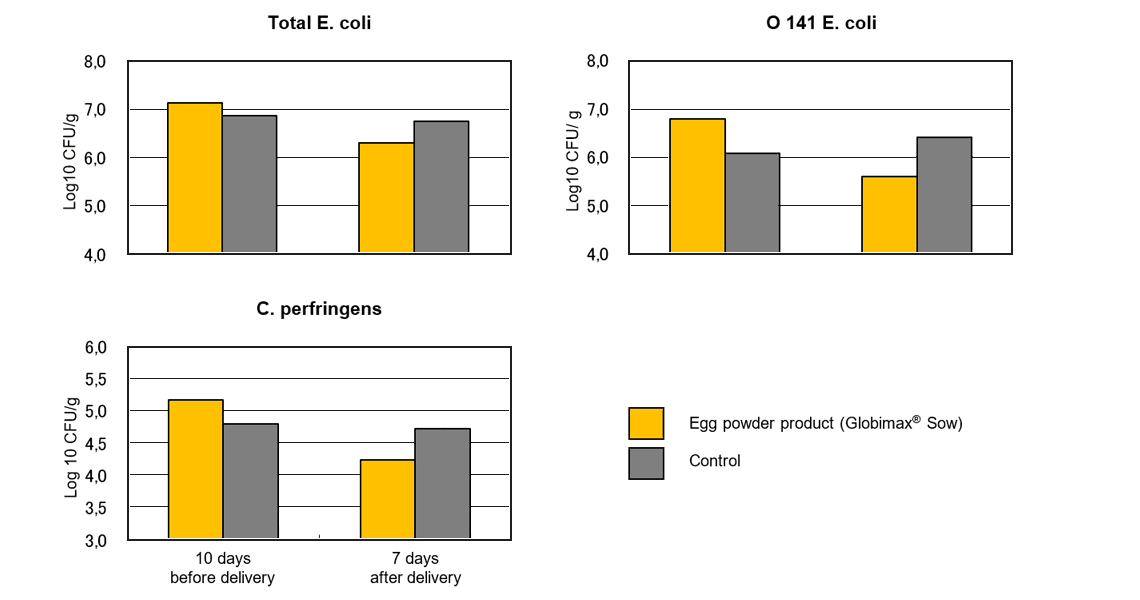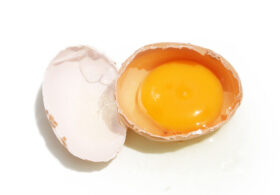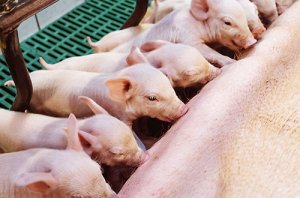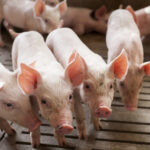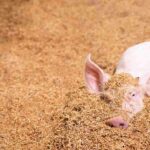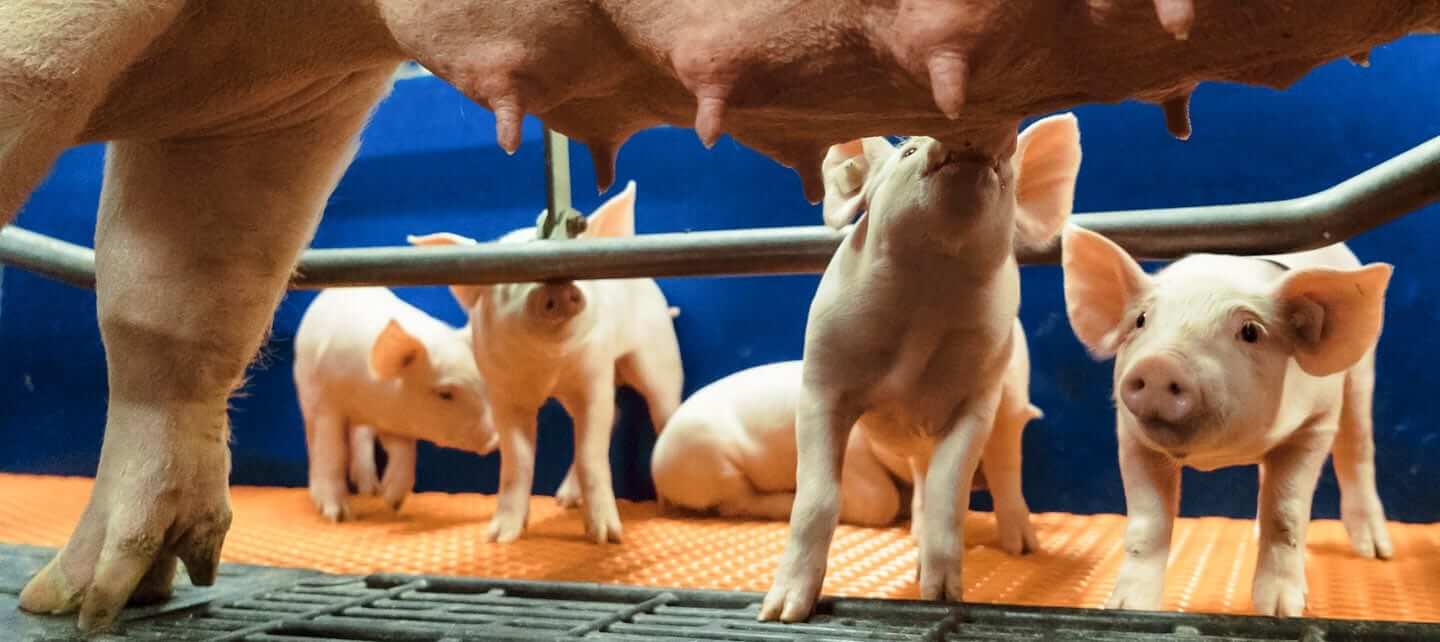
The most important parameters for a pig producer are the number of healthy pigs weaned/sow/year and their weaning weight. Due to improved genetics, it is possible today to find production systems that deliver more than 30 pigs weaned/sow/year. Strategies to increase sow productivity need to take into account the management, feeding, and health of both the piglets and the sows.
Pigs’ start in life – limited energy reserves and practically no immune protection
It is generally known that pigs are born physiologically immature. Their energy reserves are limited. They only possess 1-2 % fat, the main part of which is subcutaneous or structural fat protecting organs, joints and skin. Thus, the young pigs depend on the glucose of the glycogen deposits in the liver as main source of energy. This energy supply only meets their requirements for the first few hours.
Besides that, pigs cannot count on maternal antibodies. Unlike in humans, a sow’s placenta is not built to enable the transfer of these protective cells within the womb. At birth, the amount of protective cells in a pig’s intestine, the main site of pathogenic contamination, is therefore virtually zero. As they are born without any immune protection, new-born pigs rely on an early supply of antibodies from the maternal colostrum. During the first 24-36 hours after birth, antibodies are absorbed in the intestine and pass directly to the bloodstream. The intestinal barrier then closes. Importantly, the content of antibodies in the colostrum decreases with every hour after birth.
Prevention – the best way to protect the progeny!
Given this difficult situation in the early stages of life, it is clear that the farrowing unit should be as comfortable as possible for the young animals:
- It should be warm, as low temperatures contribute to hypoglycemia. The search for body heat at the sow additionally increases the risk of crushing, one of the main causes of pig losses. The problem arising here is that sows and the new-born pigs have different temperature requirements. One good solution is a heat lamp, installed specifically for the piglets.
- It should be clean, and pathogenic pressure should be as low as possible. Due to their poor immune status, young pigs are susceptible to diarrhea-causing pathogens like E. coli and Clostridium perfringens during their first days of life. In order to meet hygiene requirements, the first step is a careful cleaning and disinfection of the farrowing unit prior to placing the sows/gilts.
Sows’ manure – the first source of contamination
Cleaning both the farrowing unit and also the sows/gilts before placing them is helpful. Producers, however, have to understand that a sow is continuously shedding pathogens through her feces and that her young come into contact with them. In fact, sow manure is the first source of contamination for new-born pigs.
There are several methods to decrease pathogens within the sow’s gut. Feeding them natural substances such as probiotics or phytomolecules (also known as secondary plant compounds) in order to improve gut health is one possibility: beneficial microbes such as lactobacilli or bifidobacteria compete with pathogens such as E. coli or clostridia for nutrients and prevent their proliferation. Phytomolecules such as carvacrol and cinnamaldehyde, on the other hand, were found to have antimicrobial properties.
Could feeding them egg immunoglobulins be another possibility?
Egg immunoglobulins – the key to reduce pathogenic pressure?
Yokoyama et al. (1992 and 1997) already showed that immunoglobulins from eggs applied to piglets bind to pathogens within their intestinal tract. If they also bind pathogens in the sow’s gut – generating harmless complexes – this could be the key to reduce pathogenic pressure in the farrowing unit.
Trial
Method
To evaluate this possibility a trial was conducted in Japan. Two groups of eight sows were used. The sows of the control group received standard lactation feed. The trial group was also fed standard feed, but additionally received a supplement containing egg powder product (EPP) with immunoglobulins* at a dosage of 5g/sow twice daily during the last ten days before and the first seven days after delivery. The feces of the sows were obtained by rectal stimulation (in order to rule out contamination from the environment) on day 10 before and day 7 after delivery. The amount of colony-forming units (CFU) of total E. coli, E. coli O141 and Clostridium perfringens was determined.
Results
The results are shown in figure 1. At the beginning of the trial, before the application of the EPP, both groups showed nearly the same level of the pathogens evaluated, with a slight disadvantage for the EPP group. After 17 days of using the EPP, the sows of the EPP group showed lower levels of pathogens in their excrements than the sows of the control group. A reduction in the colony-forming units of total Escherichia coli (from 107.12 to 106.3), Escherichia coli O141 (from 106.8 to 105.6) and of Clostridium perfringens (from 105.17 to 104.24) could be seen.
*The product used in this trial was Globimax® Sow, EW Nutrition.
Egg immunoglobulins – a tool to optimize conditions in the farrowing unit
It is important for pig producers to understand how they can combat adverse influences on their animals’ performance. The results of this trial showed that supplementing the standard sows’ diets with the EPP substantially reduced the amount of pathogenic colonies in sow’s manure. Reducing pathogenic pressure in the farrowing unit is central to reducing the incidence of diarrhea and pre-weaning mortality. Giving young pigs the best possible start in life sets them up for delivering the best possible performance – and more healthy and heavy pigs weaned/sow/year means a more profitable farm.
Figure 1: Amounts of total E. coli, O 141 E. coli and Clostridium perfringens in the feces of sows 10 days before delivery (before the first application of EPP) and 7 days after delivery (after the last application of EPP)
By Inge Heinzl and Fellipe Barbosa
References:
Yokoyama, H., Peralta, R. C., Diaz, R., Sendo, S., Ikemori, Y. and Kodama, Y. (1992): Passive protective effect of chicken egg yolk immunoglobulins against experimental enterotoxigenic Escherichia coli infection in neonatal piglets. Infection and Immunity, March edition, 998-1007.
Yokoyama, H., Hashi, T., Umeda, K., Icatlo, F. C., Kuroki, M., Ikemori, Y. and Kodama, Y. (1997): Reduced intestinal colonization with F18-positive enterotoxigenic Escherichia coli in weaned pigs fed chicken egg antibody against the fimbriae. FEMS Immunology and Medical Microbiology (18), 153-161.

